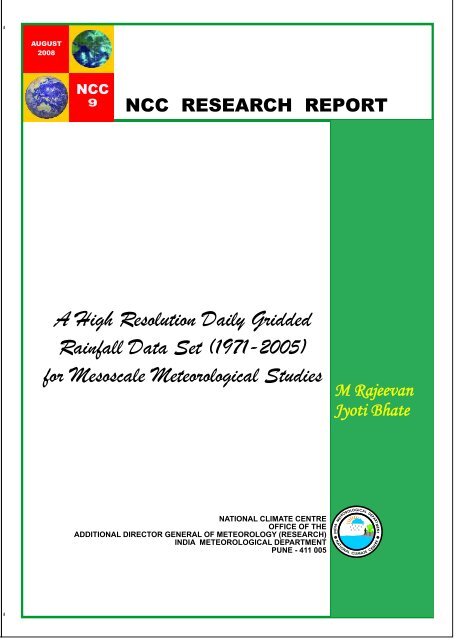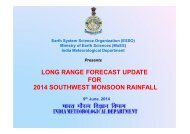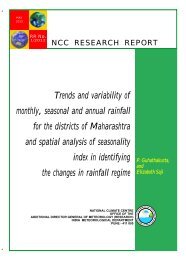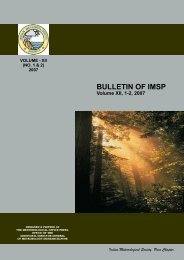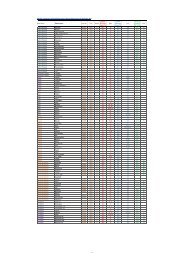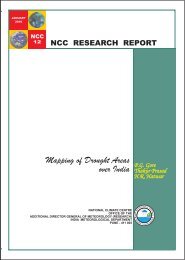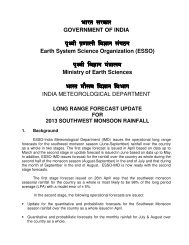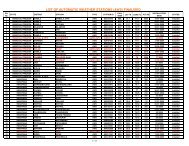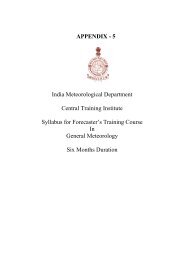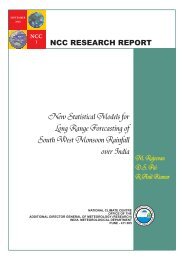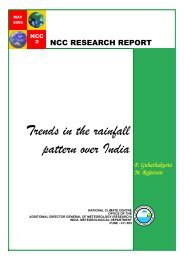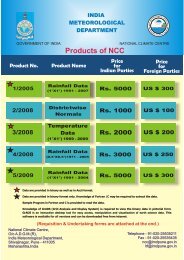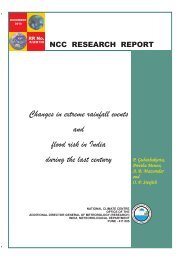A High Resolution Daily Gridded Rainfall Data Set ... - (IMD), Pune
A High Resolution Daily Gridded Rainfall Data Set ... - (IMD), Pune
A High Resolution Daily Gridded Rainfall Data Set ... - (IMD), Pune
Create successful ePaper yourself
Turn your PDF publications into a flip-book with our unique Google optimized e-Paper software.
National Climate CentreResearch Report No: 9/2008A <strong>High</strong> <strong>Resolution</strong> <strong>Daily</strong> <strong>Gridded</strong> <strong>Rainfall</strong> <strong>Data</strong> <strong>Set</strong>(1971-2005) for Mesoscale Meteorological StudiesM. Rajeevan and Jyoti BhateNational Climate CentreIndia Meteorological Department, <strong>Pune</strong>India 411 0051
AbstractIn this paper, we discuss the development of a very high resolution (0.5 0 x0.5 0 degree) daily rainfall data set for mesoscale meteorological studies over theIndian region. The data set was developed using quality controlled rainfall data frommore than 6000 rain-gauge stations over India. The analysis consists of daily rainfalldata for all the seasons for the period 1971-2005. A well tested interpolation method(Shepard’s method) was used to interpolate the station data into regular grids of 0.5X 0.5 degree Lat x Long. The data set was validated against another high resolutiondaily rainfall data set. A few case studies have been shown to demonstrate the utilityof the data set for different mesoscale meteorological analyses.1. IntroductionInformation on spatial and temporal variations of rainfall is important inunderstanding the hydrological balance on regional scale and water management inagriculture, power generation and drought management. <strong>High</strong> resolution griddedrainfall data are required to validate regional and mesoscale models and to study theintra-seasonal fluctuations. In recent years, there has been considerable interest indeveloping high resolution gridded data sets (New et al 1999, Mitra et al. 2003,Yatagai et al. 2005, Rajeevan et al. 2006, Xie et al. 2007). Rajeevan et al (2006)developed a high resolution (1 0 X 1 0 degree Lat X Long) daily rainfall data set for theperiod 1951-2004, which is being used for research studies (for example, Goswamiet al (2006) , Krishnamurthy and Shukla (2008)). However, there have beendemands for much higher resolution (say 50 km X 50 km) for mesoscale rainfallanalysis and mesoscale meteorological applications.To meet the requirements of the research community, an initiative was takenup at the National Climate Centre, India Meteorological Department (<strong>IMD</strong>) to developa high resolution (50 km spatial resolution) for mescoscale applications using dailyrainfall data archived at <strong>IMD</strong>. In this study, we discuss the development of the highresolution daily gridded rainfall data set using rainfall data from more than 6000stations for the period 1971-2005.1
2. <strong>Data</strong> and MethodologyFor the present analysis, daily rainfall data archived at the National <strong>Data</strong>Centre, <strong>IMD</strong> <strong>Pune</strong> for the period 1971-2005 have been used. Standard qualitycontrols are performed before carrying out the analysis. First, information on thelocation of the station was verified. The precipitation data themselves are checkedfor coding and typing errors. Many such errors were identified, which were correctedby referring to the original manuscripts. For the period of analysis, <strong>IMD</strong> has therainfall record of 6076 stations with varying periods. Out of these, 547 are <strong>IMD</strong>observatory stations, 494 are under the hydro-meteorology programme and 74 areAgromet stations. The remaining are rainfall-reporting stations maintained by stateGovernments. In the rainfall data set developed by Rajeevan et al. (2006), rainfalldata of only 2140 stations have been used to minimize the risk of generatingtemporal inhomogeneities in the gridded data due to varying station densities.However, for the present analysis, we have used all the available stations forinterpolating into regular grids. There were about 3500 stations on an average for thedaily analysis. However the data density varied from year to year. The network ofstations considered for the rainfall analysis is shown in Fig 1 a. The data density isnot uniform, however, there are plenty of stations from South India. The dailyvariation of number of stations used for the analysis is shown in Fig.1b. The datadensity is more or less satisfactory and uniform till 2004. <strong>Data</strong> for the year 2005 arehowever sparse. Since the data density is not kept uniform, there is a possibility oftemporal inhomogeneity and therefore, the present analysis cannot be used for trendanalysis as done by Goswami et al 6 . However, the data set is useful for many othermesoscale meteorological studies as discussed below.There are many methods of numerical interpolation of irregularly distributeddata to a regular N-Dimensional array. Bussieres and Hogg (1989) studied the errorof spatial interpolation using four different objective methods. For application to thespecific project grid, the statistical optimal interpolation technique displayed thelowest root mean square errors. This technique and Shepard OA displayed zero biasand would be useful for areal average computations. New et al (1999) used the thinplate splines for interpolation. Mitra et al (2003) used the successive correctionmethod of Cressman for merging satellite derived rainfall data and station data.2
For the present analysis, as in Rajeevan et al. (2006), we have used theinterpolation scheme proposed by Shepard (1968). In this method, interpolatedvalues are computed from a weighted sum of the observations. Given a grid point,the search distance is defined as the distance from this point to a given station. Theinterpolation is restricted to the radius of influence. For search distances equal to orgreater than the radius of influence, the grid point value is assigned a missing codewhen there are no stations located within this distance. In this method, interpolationis limited to the radius of influence. A predetermined maximum value limits thenumber of data points used, which in the case of high data density, reduced theeffective radius of influence. We have also considered the method proposed byShepard (1968) to locally modify the scheme for including the directional effects andbarriers. In this interpolations method, no initial guess is required.We have interpolated station rainfall data into a rectangle grid (69 X 65) foreach day for the period 1971-2005. The starting point of the grid is 6.5 0 N and 66.5 0E. From this point, there are 69 data points towards east and 65 data points towardsnorth. We have created one binary file for each year. For the leap year, we havecreated data for 366 days.3. Evaluation of the rainfall data set.In this section, we examine the quality of the developed 0.5 0 X 0.5 0 dailyrainfall data set. Fig.2 a and b show the spatial variation of mean (for the period1971-2005) and standard deviation of annual rainfall respectively calculated from thepresent data set. For comparison, the mean and standard deviation of rainfall duringthe same period derived from the 1 0 X 1 0 degree rainfall data set (Rajeevan et al. 4 )have been calculated and the results are shown in Fig 3 a and b respectively. Themean rainfall pattern shows maximum rainfall along the west coast and over NEIndia. Another rainfall maximum is observed over the east central parts of India. Incomparison, the data set developed in this study with 0.5 degree resolution showsmore realistic spatial variation of mean rainfall with finer details of spatial variation. Inthe mean rainfall pattern with 0.5 degree resolution data, the rainfall maximumaround Cherrapunji is clearly observed.3
Recently another high resolution rainfall data set was developed at theResearch Institute for Humanity and Nature (RIHN). The project is named as AsianPrecipitation- <strong>High</strong>ly Resolved Observational <strong>Data</strong> Integration Towards Evaluation ofthe Water Resources (APHRODITE). Under this project a high resolution (0.25degree X 0.25 degree and 0.5 X 0.5 degree) daily rainfall data set was developed forthe Asian region. The basic algorithm adopted by them is based on Xie et al. (2007).Details of the project and the data set are discussed in Yatagai et al.(2005). Thedaily APHRODITE data set is available at http://www.chikyu.ac.jp/precip/. The dataset consists of 0.5 0 X 0.5 0 degree gridded daily rainfall for the period 1980-2002. Wehave compared the present rainfall analysis with the data set developed under theAPHRODITE project. Fig. 4 a shows that correlation coefficient between thesouthwest monsoon seasonal (June to September) rainfall derived from the presentanalysis (<strong>IMD</strong> analysis) and the APHRODITE analysis. Correlation coefficient is veryhigh (exceeding 0.6) over central and NW India. The correlations are however verylow along the west coast of India and over some parts of NE India. The differencesof the southwest seasonal (June to September) rainfall between the two data setsare shown in Fig. 4 b. The APHRODITE analysis underestimates the rainfallmaximum along the west coast and NE India. Otherwise, the differences are mostlywithin 3 mm/day over the country. The basic difference between the two data sets isthe total number of stations used in the rainfall analysis. While <strong>IMD</strong> analysis usedmore than 6000 stations as mentioned above, the APHRODITE analysis used on anaverage only 2000 stations. However, the APHRODITE analysis also could capturethe large scale features of monsoon rainfall over the Indian region.4. Some Case studiesThe present <strong>IMD</strong> rainfall analysis data set can be used for many usefulmesoscale applications. In this section, we show the rainfall analysis associated withsome important weather situations. Fig 5 shows the daily rainfall maps pertaining tothe case studies considered. The first case pertains to the rainfall analysis of 24August 2000, showing the rainfall distribution associated with the monsoondepression formed over Bay of Bengal and moved northwestwards. The center ofthe depression is also shown. The maximum rainfall over the southwest sector of themonsoon depression is very well captured in the rainfall analysis. The second case4
pertains to the disastrous heavy rainfall event occurred over Mumbai on 26/27 July2005 ( Jenamani et al (2006), Bohra et al (2006)) . The rainfall map clearly shows theintense heavy precipitation exceeding 50 cm around Mumbai city. It may bementioned that the on 26/27 July 2005, intense rainfall amount occurred over a smallarea less than 2500 km 2 over Mumbai (Jenamani et al. 2006). The third example isheavy rainfall associated with the passage of a tropical cyclonic storm, whichcrossed the Andhra Coast on 6 th October, 1994. The last example is rainfall over NWIndia, associated with the passage of a winter western disturbance across thenorthern parts of India on 31 January 2003. These examples are just indicative ofmany useful applications of the present rainfall analysis.5. Summary and conclusionsIn this paper, we discuss the development of a very high resolution dailygridded (0.5 X 0.5 degree resolution) rainfall data for the Indian region for the period1971-2005. The data set has been developed using daily rainfall data from morethan 6000 stations from the country. A well tested interpolation algorithm was usedto interpolate the station rainfall data into regular grids after the basic quality controlswere made. The quality of the data set was tested by comparing the present analysiswith other gridded data set developed in Japan. Some case studies are shown todemonstrate the utility of the present data set. The data set is available for researchstudies from the National Climate Centre, India Meteorological Department, <strong>Pune</strong>(ncc@imdpune.gov.in).AcknowledgementsWe are thankful to the Director General of Meteorology, <strong>IMD</strong> and Addl.Director General of Meteorology (Research) for their encouragement and providingsupport for this study. We are also thankful to the National <strong>Data</strong> Center, <strong>IMD</strong> <strong>Pune</strong>for providing the basic rainfall data used for this analysis.5
ReferencesBohra, A.K., Swati Basu, E.N.Rajgopal, G.R. Iyengar, M.Das Gupta, R. Ashrit andB.Athiyaman, 2006, Heavy rainfall episode over Mumbai on 26 July 2005:Assessment of NWP Guidance, Current Science, 90, 1188-1194.Bussieres, N and W.Hogg, 1989, The Objective analysis of daily rainfall by distanceweighting schemes on a mesoscle grid, Atmosphere-Ocean, 3, 521-541.Goswami B.N. et al., 2006, Increasing Trend of Extreme Rain Events over India in aWarming Environment. Science 314, 1442-1445.Jenamani, R., S.C.Bhan and S.R.Kalsi, 2006, Observational/forecasting aspects ofthe meteorological event that caused a record highest rainfall in Mumbai,Current Science, 90, 1344-1362.Krishnamurthy, V and J.Shukla, 2008, Seasonal persistence and propagation ofintraseasonal patterns over the Indian summer monsoon region, ClimateDynamics, 30, 353-369.Mitra, A.K., M.Das Gupta, S.V.Singh and T.N.Krishnamurti, 2003, <strong>Daily</strong> rainfall forthe Indian monsoon region from merged satellite and raingauge values: Largescale analysis from real time data, J.Hyrdrometeorology, 4, 769-781.New, M, Hulme, M. and Jones, P.D., 1999, Representing Twentieth-Century Space-Time Variability. Part I: Development of a 1961-1990 Mean Monthly TerrestrialClimatology, J.Climate, 1999, 12, 829-856.Rajeevan, M., Bhate, J., Kale, J.D. and B. Lal, 2006, <strong>High</strong> resolution daily griddedrainfall data for the Indian region: Analysis of break and active monsoon spells,Current Science, 91, 3, 296 – 306.Shepard, D., 1968, A two-dimensional interpolation function for irregularly spaceddata, Proc. 1968 ACM Nat. Conf, 517-524.Xie, P., A. Yatagai, M. Chen, T. Hayasaka, Y. Fukushima, C. Liu, and S. Yang, 2007,A gauge-based analysis of daily precipitation over East Asia, Journal ofHydrometeorology, 8, 607-627.Yatagai, A., Xie, P., Kitoh, A, 2005, Utilization of a new gauge-based dailyprecipitation dataset over monsoon Asia for validation of the daily precipitationclimatology simulated by the MRI/JMA 20-km-mesh AGCM, SOLA, 1, 193-196, doi:10.2151/sola.2005-050.6
Fig.1a: Network of raingauge stations used for the analysis.Total number of stations: 60767
4500NUMBER OF STATIONS PER DAY (0.5 DEGREE DATA)1971-20054000F3500300025002000150010005001971197319751977NUMBER OF STATIONS19791981198319851987198919911993199519971999200120032005Y E A RFig.1 b : Time series of total number of stations used for therainfall analysis per day for the period 1971-2005.8
Fig.2 a) : Mean Annual rainfall (mm/day) using thepresent 0.5 degree analysisFig.2 b) : Standard deviation of Annual rainfall (mm/day)using the 0.5 degree analysis.9
Fig.3 a) : Mean Annual rainfall (mm/day) using the1.0 degree analysis of Rajeevan et al. (2006)Fig.3 b) : Standard deviation of Annual rainfall (mm/day)using the 1.0 degree analysis of Rajeevan et al. (2006)10
Fig.4 a) : Spatial pattern of correlation between the seasonal rainfall (June to September)from the present <strong>IMD</strong> rainfall analysis and the APHRODITE analysis. Period: 1980-2002.Fig.4 b) Spatial pattern of the differences (mm/day) between the seasonal rainfall (June toSeptember) from the <strong>IMD</strong> rainfall analysis and APHRODITE analysis. Period: 1980-2002.11
( a ) (b )(c) ( d )Fig. 5 : Case studies using the <strong>IMD</strong> 0.5 degree rainfall analysis a) <strong>Rainfall</strong> due to themonsoon depression on 24 August 2000 b) Heavy rainfall over Mumbai on 27 July 2005 c)<strong>Rainfall</strong> due to the Tropical Cyclone on 6 October 1994 d) <strong>Rainfall</strong> due to a winter westerndisturbance on 31 January 2003. Note the difference in the rainfall scales.12


